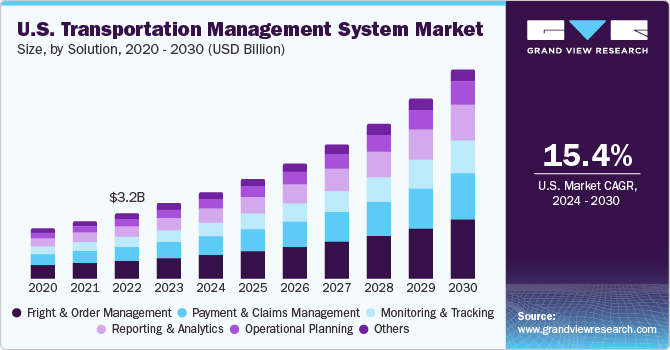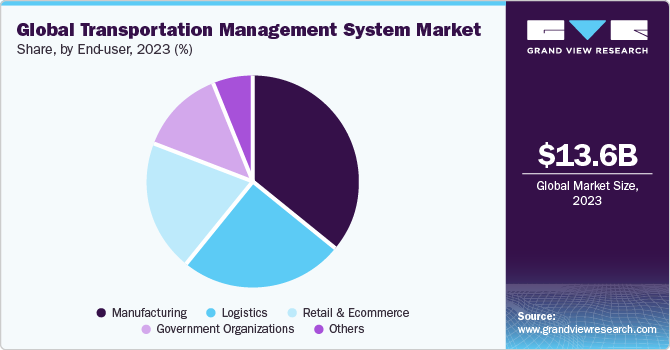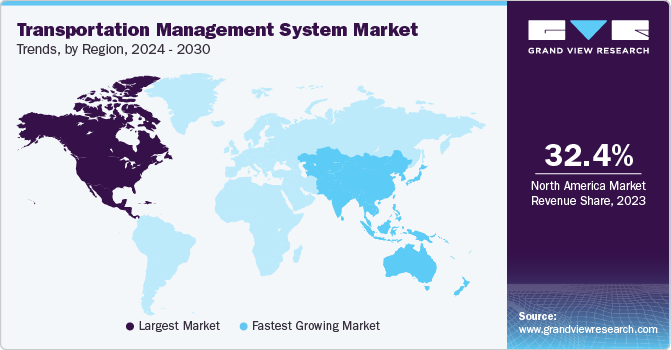- Home
- »
- Automotive & Transportation
- »
-
Transportation Management System Market Report, 2030GVR Report cover
![Transportation Management System Market Size, Share & Trends Report]()
Transportation Management System Market Size, Share & Trends Analysis Report By Solution (Operational Planning, Freight & Order Management), By Deployment, By Mode Of Transportation, By End User, By Region, And Segment Forecasts, 2024 - 2030
- Report ID: GVR-2-68038-973-9
- Number of Report Pages: 100
- Format: PDF, Horizon Databook
- Historical Range: 2018 - 2022
- Forecast Period: 2024 - 2030
- Industry: Technology
Market Size & Trends
The global transportation management system market size was evaluated at USD 13.61 billion in 2023 and is expected to grow at a compound annual growth rate (CAGR) of 17.4% from 2024 to 2030. The factors driving the global transportation management system (TMS) market include the growth of retail and e-commerce industries, consistent advancement in technology leading to the introduction of innovative solutions in the market, and the strengthening of bilateral trade relations among various countries across the world. Further, TMS solutions help automate the manual tasks of supply chain operations, including planning and execution, route optimization, and shipment tracking. Thus, it helps reducing manual errors, saves time, and costs involved in managing transportation operations are the key factors driving the market growth.

Transportation management systems play a primary role in supply chains, significantly affecting various aspects of the process, from operational planning, procurement, logistics, and lifecycle management. TMS offers deep visibility that helps in efficient transportation planning and monitoring, driving enhanced customer experience. Further, the dynamically expanding global trade environment and transits are making it highly crucial for businesses to have a TMS system that can allow them to successfully navigate complex transit operations and processes around trade policies and compliance. Thus, the following factors are aimed at driving the market growth.
In recent years, transportation and logistics industries in emerging countries have come under significant pressure from growing consumer demands, rising competition from start-ups and rival logistics operators, and changing customer expectations. Most logistics companies in countries in the APAC region utilize advanced IoT technologies to localized inventory and manage orders instead of supply chains, fleets, and assets. For instance, Here Technologies, a location platform solution provider based in the Netherlands, conducted an "APAC on the Move 2023 Survey" to offer insights on the current trends in the supply chain, logistics, and fleet management. The survey offered insights on robotics, drones, machine learning, and artificial intelligence, which are the most likely investments among logistics companies in APAC. The survey found that 45% of APAC logistics companies are utilizing shipment monitoring and asset tracking solutions with manual inputs to shipments, tracking assets, and cargo. Thus, these are the primary factors expected to drive the market growth.
AI is being implemented in several industries, including transportation, supply chain, and logistics. The growing size of data in transportation and supply chain management is driving the need for more effective data processing solutions. As such, transportation management systems are increasingly using AI to track data in real-time and optimize efficiency. For instance, several businesses in the transportation sector are using IBM Watson, which integrates AI in transportation management to identify damages to logistics assets. The solution also optimizes transportation routes and manages the network through its predictive analysis, thereby leveraging cognitive visual recognition capabilities that are anticipated to drive the market growth.
Inefficiencies in transportation operations between the source and destination can significantly increase the overall cost and success of the operation. Similarly, it can also lead to customer dissatisfaction and frustration, tarnishing the brand’s reputation. Hence, various industries are involved in deploying advanced TMS solutions in their business processes to minimize errors and discrepancies, saving the company from financial losses and protecting its reputation. TMS aims to provide new forms of optimization solutions that can enhance the ROI for end-users and bring operational efficiency within the business processes. Deployment of TMS solutions also helps in noticeable freight savings by streaming and optimizing transportation and supply chain operations, including efficient routing, selection of low-cost transport modes, and better procurement negotiations.
Key companies in the market are taking various strategic initiatives, including new product launches, mergers and acquisitions, and partnerships to offer advanced solutions and service offerings. For instance, in May 2023, BlackBerry Limited announced a strategic partnership with McLeod Software, a leading transportation management system provider. Based on the partnership, BlackBerry Radar, which offers innovative asset tracking and monitoring solutions for intermodal containers, chassis, trailers, equipment, and railcars, is aimed at integrating directly into McLeod Software's Loadmaster trucking dispatch management system with the intent to support McLeod's customers in gaining actionable and real-time insights on the status of their assets.
Solution Insights
The freight & order management segment accounted for the largest market share of 25.34% in 2023. The growing customer-centric offerings require more intelligent solutions to engage customers and provide the right product through the right channel with significant speed and convenience based on customer requirements. Organizations are looking for advanced transportation management, logistics, and supply chain solutions that can manage the freight and order management processes, helping businesses to adapt and scale faster by ensuring a seamless customer experience from onboarding to delivery and support. Freight & order management allows businesses to estimate orders, inventory availability, real-time delivery status, and fulfillment, allowing them to gain a competitive advantage and deliver enhanced customer experience are the key factors expected to drive the market growth.
The reporting & analytics segment is expected to grow at a CAGR of 19.3% during the forecast period. Report & analytics TMS enables businesses to collect and integrate relevant data across various operational areas to gain business-related and specific insights, which are crucial for strategic and operational decision-making. It offers end-to-end visibility and custom reports, including fuel charges, freight and transportation expenses, and taxes, among others, allowing companies to boost service performance, drive informed decision-making, and trim additional expenses. Thus, these are the key factors aimed at driving the segment's growth in the market.
Deployment Insights
The on-premise segment accounted for the largest market share of over 56.85% in 2023. Various manufacturing and distribution enterprises largely rely on the on-premise deployment mode for transportation management system solutions owing to the safety requirements, ease of access to the server, and greater control over customization. However, with the awareness of the benefits of the cloud's low cost of implementation as compared to the on-premise deployment, end users are expected to adopt advanced cloud-based transportation management.
The cloud-based segment is expected to grow at a CAGR of 18.4% during the forecast period. Cloud-based transportation management systems have gained increased popularity in recent years owing to the quick and easy setup, low initial cost, and reduced dependency on hardware requirements. It offers significant planning and optimizing advantages to vendors, shippers, and logistics providers. With the rising amount of data being generated, companies are actively looking for cloud-based TMS solutions as they offer a cost-effective alternative as compared to premise deployment, primarily reducing the licensing, data storage, and technical labor costs, thereby minimizing the overall operational costs.
Mode Of Transportation Insights
The roadways segment accounted for the largest market share of over 41.76% in 2023. Roadways are among the most common transportation modes and are relatively cheaper compared to other modes. Moreover, it is flexible and makes loading and unloading possible at any destination. However, there are certain limitations to road transportation, such as limited carrying capacity, multipoint police checks, poor road conditions, traffic, and others. However, continuous government initiatives in emerging economies to improve the transportation infrastructure are expected to flourish the demand for logistics through roadways, hence influencing the demand for the market for the roadways segment.
The railways segment is expected to grow at a CAGR of 18.1% during the forecast period. The rising government initiatives for the upgradation of railways through the Public Private Partnership (PPP) are expected to drive the growth of TMS in the following segment. Railways play a significant role in cargo handling by the transportation of goods and consignment in large volumes of cargo via special wagons to carry cargo in a lesser in-transit time than roadways.
End User Insights
The manufacturing segment accounted for the largest market share of over 36.25% in 2023. The growing number of manufacturing units in countries such as Mexico and India has led to an increase in the outsourcing of raw materials, inventories, and other materials required for manufacturing activities. Furthermore, increasing imports and exports and trade relations between countries are expected to boost the demand for shipping services, which would ultimately drive market growth. For instance, the Indian government’s ‘Make in India’ initiative has put a strong emphasis on the domestic manufacturing sector, which has triggered the local market growth.

The retail & e-commerce segment is expected to grow at a CAGR of 18.8% during the forecast period. Retailers use the transportation management system for a wide range of purposes, including managing, storing, and analyzing data in real-time. A retailer's success depends on extending its reach to customers through multiple stores and managing its supply chains efficiently to provide a unique customer experience. Furthermore, growing demand for online retail and rising competition in the industry to provide seamless customer experience enable retailers to adopt advanced technologies such as multi-cloud management that simplify workflows, improve customer experience, and reduce IT operating costs.
Regional Insights
North America dominated the global TMS market in 2023 with a revenue share of over 32.44%. The North American region is known for its fast-paced adoption of roadways as the key mode of transportation for moving freight and delivering goods. The rising spending by local municipalities on connected infrastructure is aimed at creating a favorable and smooth transit environment. It is among the key factors driving the growth of the North America TMS market. Moreover, the presence of various leading TMS vendors, including IBM Corporation, JDA Software Group Inc., Manhattan Associates, and MercuryGate International Inc., among others, providing numerous solutions to the consumers is also expected to strengthen the regional market growth.

The Asia Pacific segment is expected to grow at a CAGR of 19.9% during the forecast period. The rising retail and e-commerce industries in China, India, Singapore, and Indonesia are aimed at driving the Asia Pacific region’s market growth during the forecast period. Further, the launch of the ASEAN Economic Community (AEC) is expected to play a major role in regional economic integration and the implementation of regulations encouraging the growth and development of trade across the region.
Key Companies & Market Share Insights
The key operating players in the transportation management system market are broadening their offerings by utilizing a variety of strategic initiatives, such as mergers, partnerships, and acquisitions. For instance, in October 2023, The Descartes System Group, Inc. announced the launch of various solutions, including the fleet control tower, a customer engagement platform, proactive driver safety training, advanced optimization for couriers, and asset tracking, among others. The solutions would help the company to enhance its capabilities in telematics, routing, and mobile solutions.
Key Transportation Management System Companies:
- BluJay Solutions Ltd.
- Cargobase
- Cerasis, Inc.
- GoComet
- 3GTMS
- Infor Inc.
- IBM Corporation
- JDA Software Group, Inc.
- Manhattan Associates
- MercuryGate International, Inc.
- Oracle Corporation
- SAP SE
- The Descartes System Group Inc.
- Trimble Transportation Enterprise Solutions, Inc.
Transportation Management System Market Report Scope
Report Attribute
Details
Market size value in 2024
USD 15.88 billion
Revenue forecast in 2030
USD 41.57 billion
Growth Rate
CAGR of 17.4% from 2024 to 2030
Base year for estimation
2023
Historical data
2018 - 2022
Forecast period
2024 - 2030
Report updated
December 2023
Quantitative units
Revenue in USD Billion and CAGR from 2024 to 2030
Report coverage
Revenue forecast, company market share, competitive landscape, growth factors, and trends
Segments covered
Solution, deployment, mode of transportation, end user, region
Regional Scope
North America; Europe; Asia Pacific; Latin America; Middle East & Africa
Country Scope
U.S.; Canada; Mexico; UK; Germany; France; Italy; Spain; China; India; Japan; South Korea; Australia; Brazil; Argentina; U.A.E; Saudi Arabia; South Africa
Key companies profiled
BluJay Solutions Ltd.; Cargobase; Cerasis, Inc.; GoComet; 3GTMS; Infor Inc.; IBM Corporation; JDA Software Group, Inc.; Manhattan Associates; MercuryGate International, Inc.; Oracle Corporation; SAP SE; The Descartes System Group Inc.; The Descartes System Group Inc.; Trimble Transportation Enterprise Solutions, Inc.
Customization scope
Free report customization (equivalent up to 8 analysts working days) with purchase. Addition or alteration to country, regional & segment scope.
Pricing and purchase options
Avail customized purchase options to meet your exact research needs. Explore purchase options
Global Transportation Management System Market Report Segmentation
This report forecasts revenue growth at regional and country levels and provides an analysis of the latest industry trends in each of the sub-segments from 2018 to 2030. For this study, Grand View Research has segmented the global transportation management system market based on solution, deployment, mode of transportation, end user, and region:
-
Solution Outlook (Revenue, USD Billion, 2018 - 2030)
-
Operational Planning
-
Freight & Order Management
-
Payment & Claims Management
-
Monitoring & Tracking
-
Reporting & Analytics
-
Others
-
-
Deployment Outlook (Revenue, USD Billion, 2018 - 2030)
-
On-premise
-
Cloud
-
-
Mode of Transportation Outlook (Revenue, USD Billion, 2018 - 2030)
-
Roadways
-
Railways
-
Waterways
-
Airways
-
-
End User Outlook (Revenue, USD Billion, 2018 - 2030)
-
Retail & Ecommerce
-
Manufacturing
-
Logistics
-
Government Organizations
-
Others
-
-
Regional Outlook (Revenue, USD Billion, 2018 - 2030)
-
North America
-
U.S.
-
Canada
-
Mexico
-
-
Europe
-
Germany
-
U.K.
-
France
-
Italy
-
Spain
-
-
Asia Pacific
-
China
-
India
-
Japan
-
South Korea
-
Australia
-
-
Latin America
-
Brazil
-
Argentina
-
-
Middle East & Africa
-
U.A.E
-
Saudi Arabia
-
South Africa
-
-
Frequently Asked Questions About This Report
b. The global transportation management system market size was estimated at USD 13.61 billion in 2023 and is expected to reach USD 15.88 billion in 2024.
b. The global transportation management system market is expected to grow at a compound annual growth rate of 17.4% from 2024 to 2030 to reach USD 41.57 billion by 2030.
b. The on-premise segment accounted for the largest transportation management systems market share of over 56.85% in 2023. SVarious manufacturing and distribution enterprises largely rely on the on-premise deployment mode for transportation management system solutions owing to the safety requirements, ease of access to the server, and greater control over customization.
b. The roadways segment accounted for the largest market share of over 41.76% in 2023. Roadways are among the most common transportation modes and are relatively cheaper compared to other modes. Moreover, it is flexible and makes loading and unloading possible at any destination.
b. The manufacturing segment accounted for the largest market share of over 36.25% in 2023. The growing number of manufacturing units in countries such as Mexico and India have led to an increase in the outsourcing of raw materials, inventories, and other materials required for manufacturing activities.
b. North America dominated the global TMS market in 2023 with a revenue share of over 34.70%. The North American region is known for its fast-paced adoption of roadways as the key mode of transportation for moving freight and delivering goods.
Share this report with your colleague or friend.
![gvr icn]()
NEED A CUSTOM REPORT?
We can customize every report - free of charge - including purchasing stand-alone sections or country-level reports, as well as offer affordable discounts for start-ups & universities. Contact us now
![Certified Icon]()
We are GDPR and CCPA compliant! Your transaction & personal information is safe and secure. For more details, please read our privacy policy.
We are committed towards customer satisfaction, and quality service.
"The quality of research they have done for us has been excellent."





